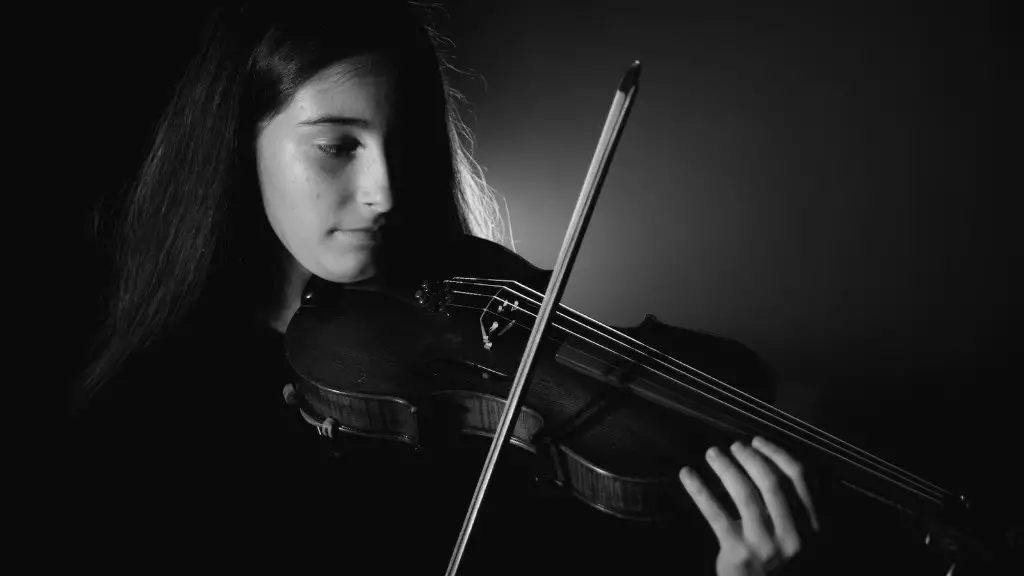The 4/4 violin is the most common size of violin, and is also referred to as a full-size violin. It is the size most adult players use and is typically recommended for players over the age of 12.
The 4/4 size of a violin will vary depending on the manufacturer, but the average measurement from the top of the scroll to the bottom of the instrument is 23.5 inches (59.6 cm). The typical width at its widest point is 8.5 inches (21.5 cm).
The 4/4 size is not only used for violins but also for many other string instruments such as violas, cellos, and double basses. It is important to note that while a 4/4 size instrument may look very similar across different types of stringed instruments, they are not interchangeable.
Why Does Size Matter for Violins?
The size of a violin plays an important role in determining the sound it produces. Generally speaking, larger violins tend to produce a fuller, richer sound, while smaller violins produce a brighter and more focused sound. A 4/4 violin is considered full-sized and is the most common size for adult players. This size is also referred to as a ‘full-size’ or ‘concert-level’ instrument. The 4/4 violin has a total length of 23 inches (58 cm) and its strings have a scale length of 13 inches (33 cm). The 4/4 size is the best choice for adult players because it provides them with the ideal balance between sound quality and comfort when playing. It is also the preferred size for professionals and orchestras.
When choosing an appropriate size for younger players, it is important to consider their age, height, and arm length. Smaller sizes such as 1/32, 1/16, 1/10 are typically used by children aged 5 to 8 years old. Intermediate sizes like 1/8 or 3/4 are suitable for students aged 8 to 12 years old. Finally, full-sized instruments such as 4/4 are suitable for adults or students over 12 years of age.
Standard Sizes of Violins
Violins come in a variety of sizes, from very small up to full-size. The standard size is the 4/4 (full-size) violin, which measures 23.5 inches long from the tip of its scroll to the bottom of the rib. The 4/4 size is the most popular and most suitable for adults; smaller sizes are used for younger players or those with smaller hands. A 3/4 violin measures 22.8 inches long and is suitable for older children; a 1/2 violin measures 21.7 inches and is typically used by beginners or by children under 8 years old; and a 1/4 violin measures 20 inches and is suitable for very young children. It’s important to choose the right size violin based on your own body type, age, and playing style.
Measuring the Size of a Violin
Measuring the size of a violin is an important part of purchasing one. The standard size for a violin is referred to as 4/4, which is full size. However, there are also smaller sizes such as 3/4 and 1/2, which are commonly used by younger players or those with smaller hands. When measuring the size of a violin, it is important to note the length of its body and the width of its neck. For example, a 4/4 full-sized violin typically has a body length between 14 and 14.5 inches and a neck width of 1.75 to 2 inches.
In addition to length and width measurements, it’s also important to consider other factors when determining the size of a violin such as string height, bridge height, and fingerboard radius. All these measurements combined determine how comfortable it will be for you to play the instrument and how well you can reach all areas of the fingerboard. It’s important to remember that when buying or renting a violin, you should always measure it against your own body before making a final decision. A proper fitting instrument is essential for producing quality sound.
Are All Sizes of Violins the Same?
No, all sizes of violins are not the same. A 4/4 violin is a full-sized instrument, measuring about 14 inches from the top of the scroll to the bottom of the instrument. It is usually considered too large for some beginner players, but it is a good size for an intermediate or advanced musician. Smaller violins, such as 3/4 and 1/2 sizes, are designed for younger or smaller players as they are more comfortable and easier to hold. All sizes of violins have different lengths and widths to accommodate different body types and playing styles.
No matter what size violin you choose, it’s important to make sure you have access to a qualified instructor who can help you find an instrument that fits your needs. With proper instruction and practice, even smaller instruments can produce beautiful music!
Full and ¾ Size Violins
Violins come in different sizes, with the most common being full size (4 4) and ¾ size. Full size violins are typically used by adult players or those with a larger body frame, while ¾ size violins are generally used by children or those with smaller body frames. The 4 4 size violin is the standard full-size model that is used by professional musicians and advanced players. It normally measures 14-15 inches in length from the nut to the end of the fingerboard, with a total length of 23-24 inches. The ¾ size violin measures 12-13 inches in length from the nut to the end of the fingerboard, with a total length of 21-22 inches.
The differences between full and ¾ size violins are mainly in their dimensions and playability. The smaller size of a ¾ violin makes it easier for youngsters to reach all parts of the instrument and produce better sound quality. However, it may not be suitable for larger hands or more advanced playing techniques. In contrast, full size violins provide more room for bigger hands to maneuver and allow for greater range when playing difficult pieces.
Difference Between Adult and Child-Size Instruments
When considering the size of a 4/4 violin, it is important to understand the difference between adult and child-size instruments. Adult-sized instruments are usually larger than their child-size counterparts, as they are built for adults with larger heads, arms, hands and other body parts. Furthermore, adult-sized violins have more strings and longer necks than their child-size counterparts, allowing for greater range of play and sound.
Child-sized instruments typically have shorter strings and smaller bodies than adult-sized instruments, making it easier for children to play them. Additionally, they often come with smaller fingerboards which make it easier for young players to learn the basics of playing a violin. This makes them ideal choices for beginner players.
Finally, while there may be some differences in size between adult and child-size instruments, both types can offer great quality music when properly cared for. A well made 4/4 violin can provide many years of enjoyment no matter what your age or skill level.
Final Words
The violin is an instrument of great beauty, capable of producing a wide range of sounds. It has a unique tone that can be both soothing and powerful. It can be used to create music that is both beautiful and emotive. For those who appreciate classical music, a violin is an indispensable instrument. The violin is an incredible instrument that has been played for centuries, making it one of the most enduring instruments in history.
No matter what style of music you like, the violin will bring something special to the table. Its unique sound makes it a versatile tool for creating wonderful musical pieces. With so many opportunities to explore its potential, the violin will continue to be an essential part of the classical music world for years to come.




